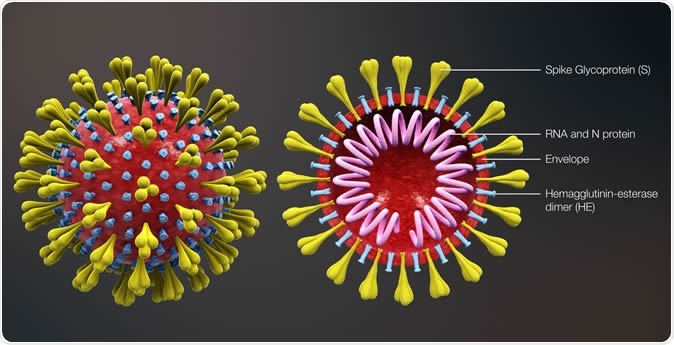Simulated sunlight kills SARS CoV-2 on surfaces in 7 to 14 minutes
by Dr. Ananya Mandal, MDResearchers led by Shanna Ratnesar-Shumate from the National Biodefense Analysis and Countermeasures Center, Operated by BNBI for the US Department of Homeland Security, have found that simulated sunlight could effectively kill severe acute respiratory syndrome coronavirus 2 (SARS-CoV-2) that is responsible for the worldwide COVID-19 pandemic. The study titled, “Simulated Sunlight Rapidly Inactivates SARS-CoV-2 on Surfaces,” was published in the latest issue of the Journal of Infectious Diseases.
What was the study about?
The Severe Acute Respiratory Syndrome Coronavirus 2 (SARS-CoV-2) is responsible for the Coronavirus Disease 2019 (COVID-19) that has resulted in a worldwide pandemic resulting in thousands of lives lost and hospitalizations across the world. The virus is highly transmissible between persons, and research has shown its persistence on surfaces that have been touched by an infected person.

Coronavirus https://www.scientificanimations.com / CC BY-SA (https://creativecommons.org/licenses/by-sa/4.0)
Locations in hospital wards and patient rooms, objects, or surfaces that have been touched by an infected person have been shown to have a presence of the SARS-CoV-2 virus particles. These can be transmitted to an uninfected person, studies have found. Studies have also shown that SARS CoV-2 can last on these non-porous surfaces at indoor conditions (specified at 23 degrees Celsius and 40 percent relative humidity) for more than a day. The maximum half-life of these organisms on these surfaces is said to be around 7 hours, say the researchers. They also write that several studies have said that multiple factors determine the amount of time the virus can survive on surfaces. Some of these factors include “temperature, humidity, sunlight, and the matrix in which the virus is suspended.”
This new study aimed to look at the influence of simulated sunlight and suspension medium matrix on the presence of the virus and its persistence on surfaces. The earlier studies have looked at the persistence of the virus on surfaces indoors only. This new study looks at the same parameters, both indoors and outdoors. This could help policymakers come up with not only assessment of the risk of exposure to contaminated non-porous surfaces, but also ways to disinfect them and break the chain of transmission.
What was done?
This is the first study that shows that sunlight can “rapidly inactivate” the SARS CoV-2 present on surfaces. It shows the difference in persistence of the virus on surfaces, indoors and outdoors.
The cells taken for the experiments were Vero cells cultured at 37°C and under 5% CO2. The virus was SARS-CoV-2 USA-WA1/2020 that was procured from the Centers for Disease Control and Prevention (CDC). A viral stock solution was prepared. Single-layer Vero cells were infected with the viral stock solution. Viral titers on the final experimental substance were measured using the Spearman-Karber method and expressed as median tissue culture infectious dose (TCID50) per mL of sample.
Sunlight exposure was measured using inactivated SARS-CoV-2 suspended in either simulated saliva or culture media and dried on diamond perforated stainless steel coupons in a controlled chamber with a quartz window. The coupons contaminated with the dried virus were exposed to simulated sunlight. For simulated sunlight, a “custom solar simulator (Sciencetech Inc.) consisting of a xenon arc lamp and a series of optical filters,” was used. Filters and power supply was used to control the intensity of the sunlight. For this study, three different light intensities were tried. The team wrote, “Viral inactivation rates for the different simulated sunlight levels and suspension media were compared…”
What was found?
The researchers noted that simulated sunlight was capable of rapidly inactivating the SARS CoV-2 on the stainless steel coupons. Results showed that 90 percent of the infectious virus was inactivated in just 6.8 minutes in saliva solution and every 14.3 minutes in a culture media. The sunlight required for this is similar to the summer solstice seen at 40oN latitude at sea level on a clear day, wrote the researchers. They added that similar inactivation was also seen at a slower rate when levels of sunlight were lower.
Conclusions and implications
There have been studies that prove that UVC light (absent in natural sunlight) could inactivate coronaviruses. This study is the first to show that UVB levels found in natural sunlight can actually inactivate SARS CoV-2 on surfaces, “specifically virus dried on stainless steel coupons.” The team wrote that this suggested that “fomite transmission may be significantly reduced in outdoor environments exposed to direct sunlight relative to indoor environments.” Local weather conditions, cloud cover, and the temperature remains a consideration, they wrote.
The team wrote in conclusion, “The present study provides the first evidence that sunlight may rapidly inactivate SARS-CoV-2 on surfaces, suggesting that persistence, and subsequently exposure risk, may vary significantly between indoor and outdoor environments. Additionally, these data indicate that natural sunlight may be effective as a disinfectant for contaminated non-porous materials.”
Journal reference:
- Shanna Ratnesar-Shumate, Gregory Williams, Brian Green, Melissa Krause, Brian Holland, Stewart Wood, Jordan Bohannon, Jeremy Boydston, Denise Freeburger, Idris Hooper, Katie Beck, John Yeager, Louis A Altamura, Jennifer Biryukov, Jason Yolitz, Michael Schuit, Victoria Wahl, Michael Hevey, Paul Dabisch, Simulated Sunlight Rapidly Inactivates SARS-CoV-2 on Surfaces, The Journal of Infectious Diseases, , jiaa274, https://doi.org/10.1093/infdis/jiaa274